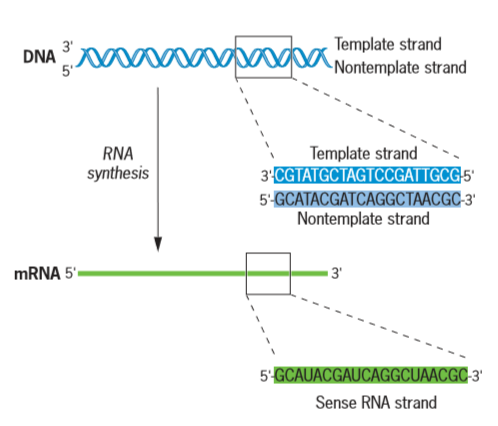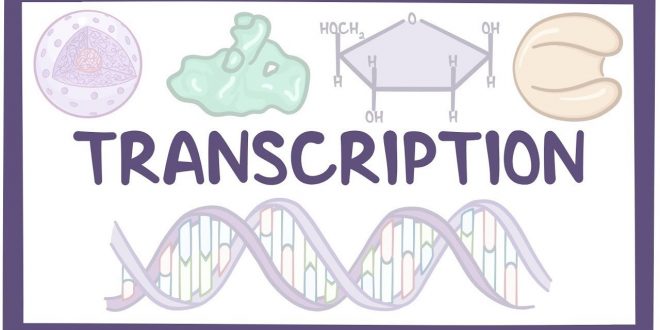Transcription is the synthesis of RNA molecule using one of the DNA strands as a template. It is the first step in the transfer of genetic information from genotype to phenotype. However, this process of transcription is a highly selective one i.e definite genes are transcribed only when their products are needed.
- The expression of genetic information occurs in two steps. 1. Transcription (DNA to mRNA) and 2. Translation (mRNA to Protein).
- The synthesis of RNA chains, like DNA chains, occurs in the 5′ to 3′ direction, with the addition of ribonucleotides to the 3′-hydroxyl group at the end of the chain.
- The mRNA carries the messages in the DNA in its own language to the ribosomes in cytoplasm for the final journey called translation.

Best safe and secure cloud storage with password protection
Get Envato Elements, Prime Video, Hotstar and Netflix For Free
Best Money Earning Website 100$ Day
#1 Top ranking article submission website
Good to know
- Bacteria such as E. coli have approximately 4000 genes, and mammals, including humans, have about 20,500 genes which, surprisingly, represent only a small fraction (about 1.5%) of the total DNA. The rest is non coding sequences.
- The human genome contains over 3 billion base pairs or nucleotides.
- Prokaryotic transcription differs from eukaryotic transcription. Description is added in the end section.
- Between euchromatin and heterochromatin, the former is active in transcription.
Requirements
Transcription usually requires three major components for a successful operation. They are:
- a DNA template
- raw materials needed to build a new RNA molecule
- the transcription apparatus; mainly composed of enzymes to catalyze the synthesis.
The DNA Template
The template of RNA synthesis is a single strand of a double helix DNA that has the definite gene that needs to be transcribed. The DNA strand used for replication is called Template strand and the other one non transcribed is the non-template strand.
- The synthesized RNA molecule is usually complementary and antiparallel to the template DNA strand.
- The RNA has the same polarity and sequence as does the non-template strand except the T in DNA is substituted by U in RNA.
The stretch of a DNA molecule that codes for an RNA or has the sequence for a protein is called a Transcriptional unit. This unit has three critical regions. Such as:
- Promoter: It is a DNA sequence that the transcription apparatus recognizes and binds. It indicates which of the DNA strand is to be transcribed and in which direction. It also determines the transcription start site, the first nucleotide that will be transcribed into RNA. In most transcription unit the promoter is located beside the transcription site but, is not itself transcribed.
- RNA coding sequence: It is a sequence of DNA nucleotide that is copied into the RNA.
- Terminator: It signals where transcription has to end. It is a part of the coding sequence so the transcription is stopped after the terminator has been transcribed.
(When discussing transcription, biologists often use the terms downstream (towards 3′ end) and upstream (towards 5′ end). Downstream direction: e.g. the RNA polymerase moves towards the downstream. The terminator is downstream to the coding sequence. Upstream direction: e.g. the promoter is upstream to the start site)
Substrate of Transcription
RNA is synthesized from ribonucleotide tri-phosphates (rNTPs). During synthesis, nucleotides are added one at a time in the 3′ OH end of the growing RNA chain. Two phosphates are cleaved from the triphosphate in this process and the remaining phosphate makes a phosphodiester bond that connects the nucleotide to the chain.
- Direction of transcription is 5′ to 3′.
The Transcription Apparatus
RNA polymerase is the only enzyme that carries out transcription. Still it requires some accessory proteins that joins and leaves the polymerase during different stages of transcription.
- Bacterial cell typically consists of only one type of RNA polymerase.
- Eukaryotic RNA polymerase has three distinct types.

Stages of synthesis
- Promoter recognition
- Chain initiation
- Chain elongation
- Chain termination
Promoter recognition
Two broad senses of sequences are important for the initiation of transcription-promoter and enhancer.
Promoter: First the RNA polymerase binds to the DNA to start the initiation of chain growth. The polymerase doesn’t bind randomly but at a specific base sequence known as promoter (from where synthesis begins). The promoter is about 20 to 200 bases in length.
Enhancer: Enhancer needs not be adjacent to the gene. They can enhance the transcription of a gene which is thousands of nucleotides away.
Chain initiation
After the initial binding, the RNA polymerase starts the unwinding of the double helix causing the expected DNA strand to be separated from its partner. Then the enzyme starts its synthesis on the template strand. The chain growth always occurs in 5′ to 3′ direction.
Chain elongation
RNA polymerase moves along the template strand and continuously adds nucleotides to the growing chain.
Chain termination
The termination of both the polymerase and the transcribed strand occurs when the polymerase finds a terminating sequence. Two kinds of terminating events are known.
1. Self terminating (most common case): Termination occurs because of a definite base sequence of the DNA strand. This causes the transcribed strand (?) to form a hairpin loop by folding back upon itself and the synthesis is arrested.
2. Requires the presence of termination protein.
The Product thus produced in mRNA.
Difference between DNA replication and RNA synthesis
| DNA replication | RNA synthesis |
| All the nucleotides in the DNA templates are copied. | Only small parts of the DNA- single gene or at best a group of genes are transcribed. |
| Occurs at both strands. | Occurs at a single strand at a time. |
| Precursor is deoxyribonucleoside triphosphate. | Precursor is ribonucleoside triphosphate. |
| DNA synthesis requires primer. | RNA chains can be initiated de novo, without any requirement for a preexisting primer strand. |
Differences between prokaryotic transcription and eukaryotic transcription
| Prokaryotic transcription | Eukaryotic transcription |
| RNA is synthesized in cytoplasm. | RNA is synthesized in nucleus. |
| Prokaryotic mRNAs often contain the coding regions of two or more genes; such mRNAs are said to be multigenic. | Can be either monogenic or multigenic. |
| Only one type of RNA polymerase. | 5 types of RNA polymerase and each catalyzes special class of genes. |
| The mRNA produced doesn’t undergo modification prior to translation. | Requires modification. |
| RNA polymerase can initiate the transcription themselves. | Requires the help of protein transcription factors. |
Source:
- Principles of Genetics – 6th edition – Snustad and Simmons
- Genetics – Heartl Jones
- Genetics: A Conceptual Approach – Pierce
Revised by Md. Siddiq Hasan on 29/07/20
Best safe and secure cloud storage with password protection
Get Envato Elements, Prime Video, Hotstar and Netflix For Free
 Plantlet The Blogging Platform of Department of Botany, University of Dhaka
Plantlet The Blogging Platform of Department of Botany, University of Dhaka






Your point of view caught my eye and was very interesting. Thanks. I have a question for you.